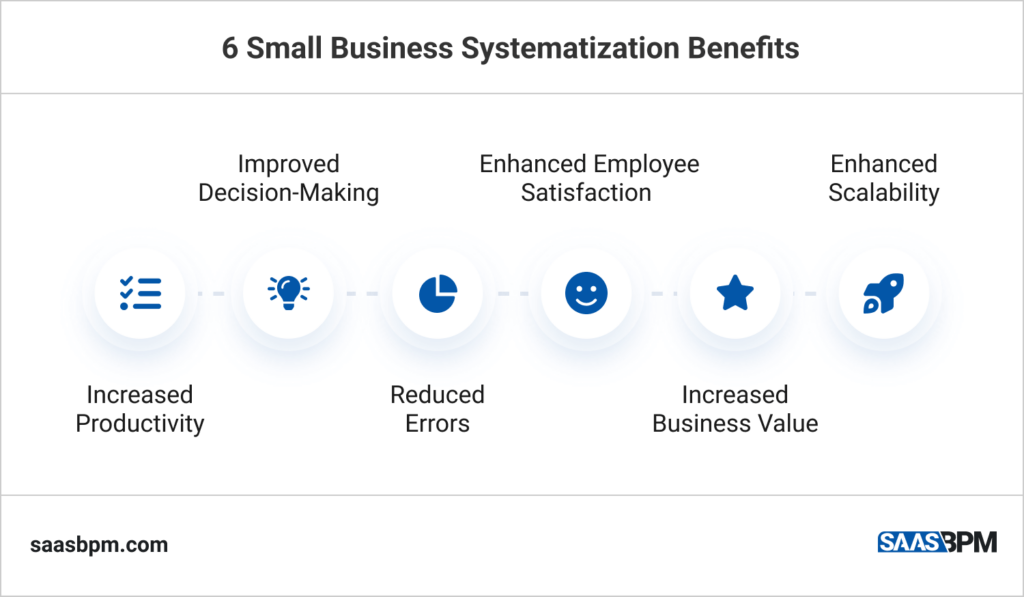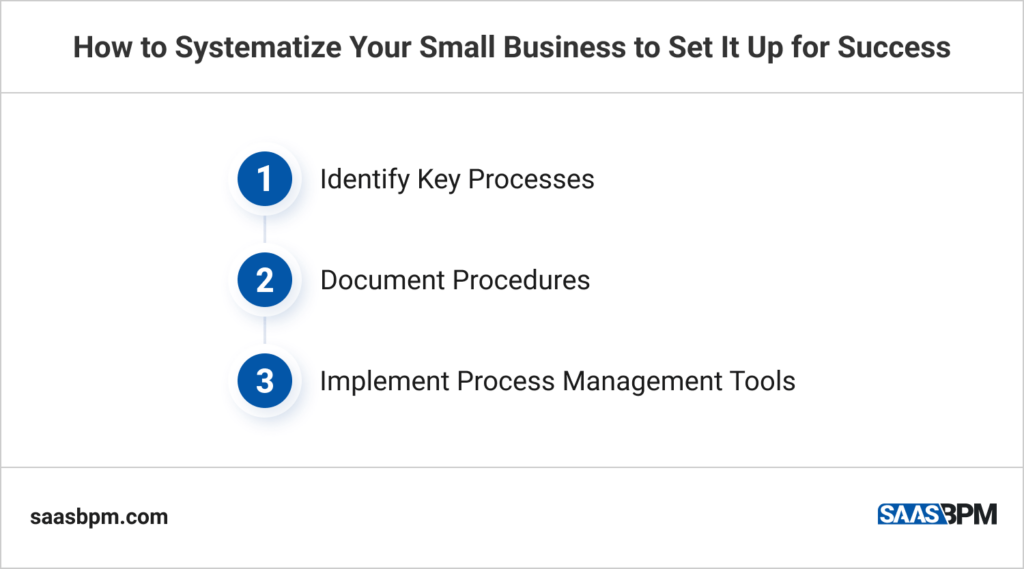Small business management requires efficient, scalable, and profitable operations. Knowing how to systematize your small business is the key to unlocking this delicate balance.
This transformative process involves creating meticulously documented processes, workflows, and standards, providing a structured roadmap for consistent and effective business practices. While the path to systematization may present challenges, the potential benefits—enhanced efficiency, improved scalability, and increased profitability—are compelling motivators.
Small businesses that embark on the journey of systematization not only fortify their foundations but also position themselves strategically for long-term success in the ever-evolving market landscape. As we delve into the nuanced world of small business systematization, the goal is clear: to empower businesses to thrive in efficiency, scale with ease, and reap the rewards of sustained profitability.
What Does It Mean To Systematize Your Business?
Systematizing a business transcends mere organizational structure. Without a comprehensive strategy to manage operations with structure, consistency, and clarity, a company is bound to fail in reaching its goals.
For small businesses aspiring to ascend to new heights, systematization is not a mere luxury; it is a strategic imperative. It instills order into the often-chaotic realm of entrepreneurship, laying the groundwork for scalability and success. Therefore, successful business systematization demands a thorough understanding of each operation within your organization. So, the creation of tangible, step-by-step guidelines that illuminate the path toward optimized efficiency is essential.
Moreover, systematization is a forward-looking endeavor, anticipating growth and expansion. It transforms the often ad-hoc nature of small business operations into a streamlined and replicable model. By defining clear procedures, roles, and expectations, systematization empowers businesses to navigate challenges more effectively and seize opportunities with agility.
Systemize vs. Systematize: Crafting a Sustainable Approach
In the realm of business optimization, understanding the nuanced distinction between systemize and systematize is fundamental to crafting a sustainable operational approach. Systemize refers to the initial creation of systems—a pivotal phase where the foundational frameworks are laid. It involves the deliberate structuring of processes, workflows, and standards to establish a cohesive operational landscape.
On the other hand, systematize goes beyond the inception stage; it represents the ongoing commitment to maintaining and refining these systems. It is a continuous endeavor to enhance the efficiency, adaptability, and effectiveness of established structures over time. Both components are indispensable in the quest for a seamlessly run business.
6 Small Business Systematization Benefits

Small business systematization yields a myriad of benefits, positioning enterprises for sustained growth, operational excellence, and enhanced profitability.
1. Increased Productivity
Systematizing a small business invariably leads to heightened productivity. Clearly defined processes and workflows eliminate confusion, enabling team members to perform tasks efficiently. With standardized procedures in place, employees can focus on execution rather than navigating procedural uncertainties. This efficiency boost contributes to enhanced output without sacrificing quality, laying the foundation for overall business success.
2. Improved Decision-Making
A well-systematized business provides a structured framework for decision-making. Clear processes and documented workflows offer insights into the intricacies of operations, empowering leaders to make informed choices. The availability of accurate and up-to-date information allows for strategic decision-making, fostering a culture of agility and adaptability. Informed decisions, guided by established systems, contribute to the overall resilience and competitiveness of the business.
3. Reduced Errors
Clever business systematization acts as a safeguard against errors and inconsistencies. By clearly defining procedures and standards, businesses minimize the risk of mistakes in task execution. Documented workflows serve as a reference, reducing the likelihood of misunderstandings or deviations from established protocols. The result is a decrease in errors, creating a more reliable and dependable business environment.
4. Enhanced Scalability
One of the primary advantages of small business systematization is its impact on scalability. As operations become more structured, businesses can seamlessly scale their activities. Standardized processes ensure that growth does not equate to chaos, enabling smooth expansion without compromising the quality of products or services. Systematization sets the stage for businesses to navigate growth opportunities with confidence and efficiency.
5. Increased Business Value
A systematically run business is inherently more valuable in the eyes of investors and potential buyers. Documented processes and organized workflows contribute to the overall appeal of the business. Investors seek assurance in a well-structured operation that can withstand transitions and changes. For small business owners looking to enhance their exit strategy or attract investment, systematization serves as a tangible asset, increasing the overall value of the business.
6. Enhanced Employee Satisfaction
Systematization fosters a positive work environment by providing clarity and structure. Employees benefit from clearly defined roles, responsibilities, and workflows. This transparency reduces ambiguity, contributing to job satisfaction and a sense of accomplishment. A satisfied and motivated workforce is more likely to contribute proactively to the success of the business.
How to Systematize Your Small Business to Set It Up for Success

Identify Key Processes
Before embarking on the systematization journey, identify the key processes that drive your business. These processes could include customer acquisition, order fulfillment, invoicing, and more. Take a holistic view of your business operations to pinpoint the core activities that contribute to your overall objectives.
Identifying key processes is a collaborative effort that involves input from various stakeholders, including employees who are directly involved in executing these processes. This step lays the groundwork for creating a systematic framework tailored to your business needs.
Document Procedures
Once you’ve identified the key processes, the next crucial step is to document the procedures associated with each one. Documenting procedures involves creating detailed, step-by-step guides for how each task within a process should be executed. Use clear language, include relevant visuals, and ensure that the documentation is easily accessible to all team members.
Documentation serves as the backbone of systematization, providing a reference point for employees and a standardized approach to tasks. It also facilitates knowledge transfer, ensuring that essential information is not dependent on individual employees but is ingrained in the documented processes.
Implement Process Management Tools
To streamline and manage the documented processes, leverage business process management tools and software such as SaaS BPM. These tools help in organizing, tracking, and optimizing workflows.
Process management solutions provide a centralized platform for collaboration, allowing team members to access and contribute to the documented processes. They often come with features such as task assignments, progress tracking, and notifications, enhancing overall efficiency and communication within the team.
Putting It All Together
In summary, systematizing your small business is not just a task; it’s a strategic investment in future success. The benefits—increased productivity, improved decision-making, reduced errors, scalability, and enhanced business value—are transformative. By following a systematic approach, small businesses can set the stage for sustainable growth and long-term prosperity. Take the first step toward systematization today, and unlock the full potential of your business.

